Gigabyte K8NNXP-940: Built on Athlon64 FX51 Strengths
by Wesley Fink on October 9, 2003 11:52 PM EST- Posted in
- Motherboards
Gigabyte K8NNXP-940: Basic Features
| Motherboard Specifications | |
| CPU Interface | Socket-940 Athlon64 FX |
| Chipset | nForce3-150 Single-Chip |
| Bus Speeds | 200MHz to 300MHz (in 1MHz increments) |
| PCI/AGP Speeds | Auto (Variable) or Fixed 66-100MHz (in 1 MHz increments) |
| Available CPU Ratios | Auto, 4X to 25X in 0.5 increments |
| Core Voltage | Normal, 0.80V to 1.70V in 0.025v increments |
| DRAM Voltage | Normal, +.1, +.2, +.3V |
| Chipset (VDDQ) Voltage | Normal, +.1, +.2, +.3V |
| Hypertransport (VCC12_HT) Voltage | Normal, +.1, +.2, +.3V |
| Memory Slots | Four 184-pin DDR DIMM Slots Dual-Channel Configuration For Registered/Registered ECC |
| Expansion Slots | 1 AGP 8X Slot 5 PCI Slots |
| Onboard Serial ATA RAID | Silicon Image Sil3112 supports Raid0/1 |
| Onboard IDE RAID | Two Standard ATA133/100/66 Plus 2 GigaRAID ATA133 IDE RAID |
| Onboard USB 2.0/IEEE-1394 | Six USB 2.0 ports supported by nF3 TI 1394B (800 Mb/s) FireWire (2 ports) |
| Onboard LAN | Two ports, Realtek Gigabit LAN + Realtek 10/100 LAN |
| Onboard Audio | Realtek ALC658 codec AC '97 2.3 6-Channel with UA |
| BIOS Revision | F1 Release 7/22/2003 |

The Gigabyte K8NNXP-940 is Gigabyte's top board for the Athlon64 Enthusiast, and the fancy embossed foil packaging tries to convey that. This is typical of recent Gigabyte top-line boards.

Gigabyte continues the recent “6-Dual Miracle” theme with the K8NNXP-940, with the Dual 32-bit/64-bit Dual CPU bandwidth replacing Hyperthreading as Athlon64's Dual. As the flagship for the Gigabyte AMD line, every feature you can imagine is lavished on the K8NNXP-940. The most significant new addition is 1394b Firewire. This is the first board that we have tested with the new 800Mb/s firewire.
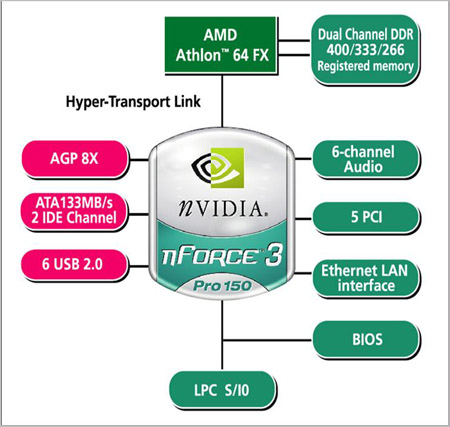
Gigabyte uses the nVidia nForce3-Pro150 single-chip solution on the K8NNXP-940. While the nF3-150 and nF3-Pro150 are currently limited to 600MHz HyperTransport, communication to the FX processor is direct and not bottlenecked by slower speed chip communications in traditional north/south bridge chipsets. The nF3-150 is used on motherboards designed for the single-channel Socket 754 Athlon64, while the nF3-PRO150 is designed for the Dual-Channel Opteron or Socket 940 FX51.
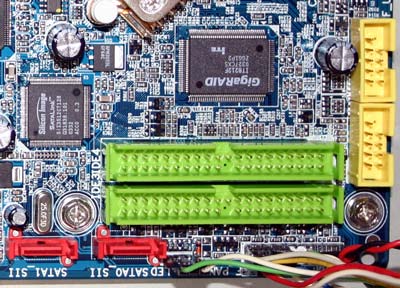
The Gigabyte uses both the GigaRAID IDE RAID based on the IT8212 chip and SATA RAID based on the well-regarded Silicon Image 3112/3512 chip. IDE RAID 0, 1, 0+1 are supported, and SATA RAID 0, 1. A full assortment of SATA/IDE cables and SATA/Molex power connectors are provided for drive hookup.

This includes Gigabytes unique external SATA bracket that allows connection of 2 external Serial ATA devices.

K8NNXP-940 uses the newest and best version of the Realtek audio codec called ALC658. This audio chips features Dolby Digital 6-channel sound and UAJ or Universal Audio Jack. This allows automatic jack programming as we've seen on some boards based on Intel's 865/875 chipsets.

If you have Dolby digital capabilities, SPDIF output is provided by an included SPDIF bracket. SPDIF out jacks are provided for both optical and coaxial connections, as well as the 2 additional jacks for rear speakers in a powered 4 to 6 speaker arrangement. This allows rear speakers/subcenter to be used, while still leaving usable microphone and audio input capabilities. Many motherboards must program the rear-panel jacks and use the mic and input jacks for a 6-speaker setup. The ability to use six speakers, mic, and audio input is a nice feature — and more unique than you might imagine.
Realtek markets the ALC658 as a premium sound solution, and their first 2.3 compliant audio codec. The ALC658 is:
The ALC658 has six 20-bit DAC channels, two pairs of stereo 18-bit ADC, and an AC'97 2.3 compatible six-channel audio CODEC designed for PC multimedia systems. The ALC658 incorporates proprietary converter technology to achieve 100dB sound quality, meeting performance requirements on PC99/2001 systems and placing PC sound quality at the same level as consumer equipment.More information on the features and specifications of ALC658 is available at Realtek.

In addition to the 2 USB 2.0 ports on the rear I/O panel, Gigabyte provides an accessory bracket with two more USB 2.0 ports and 2-800mb/sec Firewire ports (one standard and one mini). An additional 2-port USB2.0 bracket is provided if needed. It is clear that the designers put some thought into this arrangement, since many users have front USB ports on their cases and the combo USB/firewire bracket may be their only added ports.
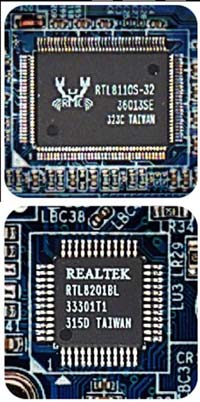
In keeping with the Dual theme, the K8NNXP-940 includes two LAN ports — a Gigabit LAN port and a 10/100 Ethernet port. Both chips are by Realtek.
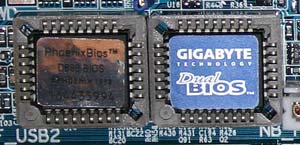
Gigabyte uses their trademark Dual BIOS on their mid- to high-end motherboards, and it is included on the K8NNXP-940. In addition to protection from a bad BIOS flash, the dual BIOS feature allows the creative end-user to set up 2 different BIOS setups for different OS or loads. In addition, the dual BIOS has hooks to allow direct flashing of the BIOS without an OS. You merely copy the BIOS file to a floppy, hit DEL during boot to enter BIOS, hit F8 to enter BIOS setup and make selections. Updating BIOS is as easy as it gets.

The K8NNXP I/O ports configuration is the assortment you will find on most high-end boards, and a custom ATX backplate is included.
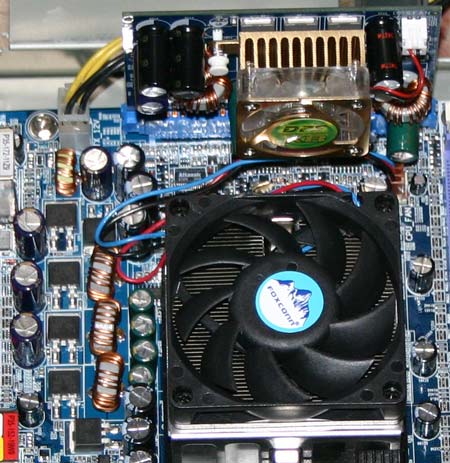
As part of their Dual Power and Dual Cooling features, Gigabyte includes the DPS-K8 power module. The base K8NNXP-940 is a 3-phase board, while adding the DPS-K8 module extends the board to 6-phase power and a second cooling fan. Gigabyte claims that the 6-phase power produces a more stable motherboard, better overclocking, and longer lasting components.
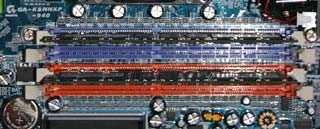
Four DIMM slots support Registered or Registered ECC Dual-Channel memory. Memory should be installed in matched pairs for Dual-Channel. Regular unbuffered DDR memory will not work in FX51 boards or in Opteron boards. Memory up to DDR400 is officially supported, which is an improvement over the DDR333 support that we have seen in past Opteron nForce3 boards.










35 Comments
View All Comments
Anonymous User - Saturday, October 11, 2003 - link
Hmm.. something just occured to me. (This is #24 again.) Anyone else remember the days of the Pentium and Pentium Pro? Well, it seems like we may be reentering the whole "high-end CPUs are different from midrange ones in ways other than clock speed" thing.. except this time around, the Macs aren't faster (the G5 and its super-deep pipeline can kiss my ass, thanks.. and probably the Hammer's while it's at it), and there are two companies in the game. This is going to be fun.Anonymous User - Saturday, October 11, 2003 - link
Hey, why isn't the Nehalem in this review? So what if it doesn't exist? They've got like 80% of it planned out now anyway, it's unfair to have this review biased towards AMD.Well, SOMEONE had to be ignorant and stupid, and hell if I'm going to say a thing about the Pentium 4 Xeon MP Edition.
Uh. Anyway. The Athlon FX may just be a rebranded Opteron, but it's cheaper than the rebranded Xeon MP and much better at its job, so who cares what's a rebranded what? Not that I'd ever buy an Athlon 64 at these prices, but it seems the only market sector Intel has left is the low high end :D
Anonymous User - Friday, October 10, 2003 - link
Excellent review! I'll be reading all of your writings from now on. :Dsandorski - Friday, October 10, 2003 - link
Sweet motherboard, makes me think that as Athlon 64/FX motherboards mature, more performance will be acheived.Anonymous User - Friday, October 10, 2003 - link
Haha, good point #20!Anonymous User - Friday, October 10, 2003 - link
#12, perhaps because P4EE does not exist...Anonymous User - Friday, October 10, 2003 - link
When will this board be released?Reflex - Friday, October 10, 2003 - link
#11: I am not reffering to Quad-Channel DDR as I think you believe. I am reffering to Quad-Data Rate SDRAM. It uses the same pin count as DDR but sends information four times per clock, resulting in twice the bandwidth as DDR. If AMD supported it in their on board controller it would not require a higher pin count.However there must be some technical reason for QDR not appearing by now since its been 'just around the corner' for over two years now...
Anonymous User - Friday, October 10, 2003 - link
Mostly I meant that running hand-compiled 64-bit apps would be irrelevant. I'd love to see another article in a few months, when Linux apps start actually arriving in 64-bit versions. But until then, it would be akin to Tom's OC'ing the P4EE. It may be interesting to a few people, but it would appear biased to almost everyone else.Anonymous User - Friday, October 10, 2003 - link
#15, 64-bit tests running linux would not be relevant? what about those of us who are running linux right now? I for one would love to see a 64-bit set of linux benchmarks included.